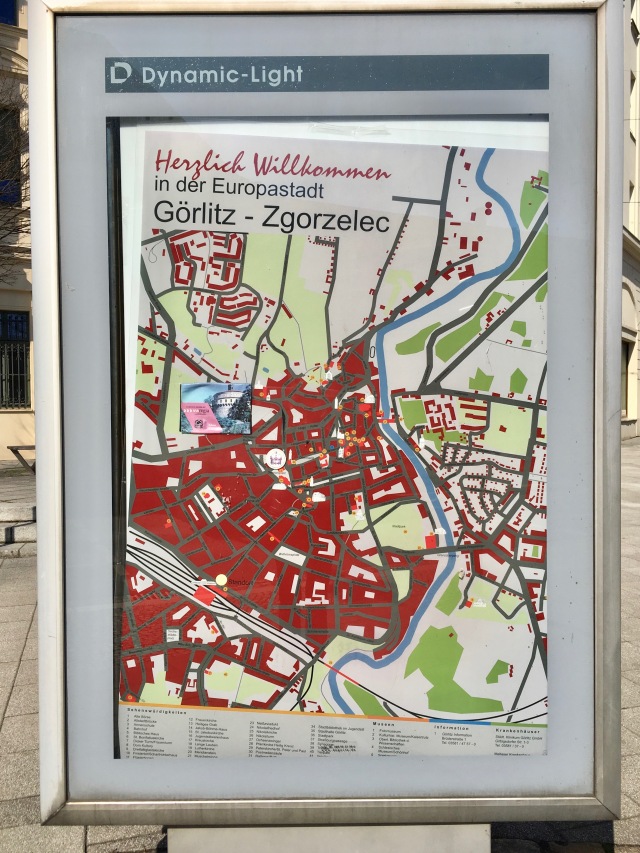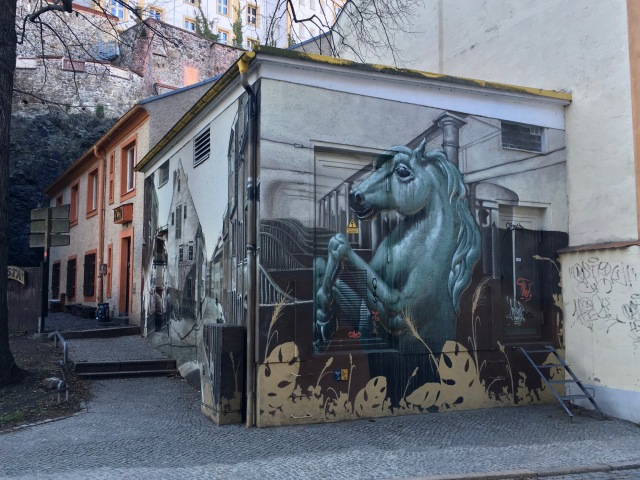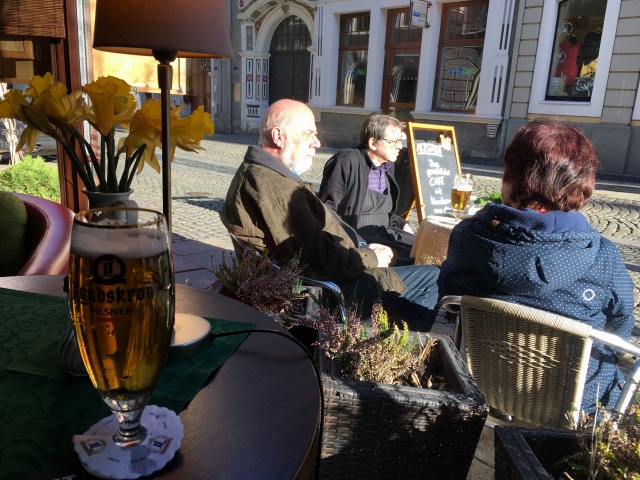Last week was an interesting confluence of the spring equinox and a full “Worm” moon, so named because of the thawing earth bringing the reappearance of earthworms and hence the robins. Well, it certainly thawed me out and put me in mind of a ramble. And since, apropos of my last blog posting, I wanted to find a place to explore that hadn’t become the Disneyland consumer mall version of its former civic self, I figured I would have more luck sniffing around in the municipalities of the old East Germany. A “Top Ten Prettiest Cities” list had drawn my attention to Görlitz, located just at the Polish border in the southeastern corner of Germany. Since trains were frequent and cheap to that destination, off I set, expecting an easy day trip and home for supper.
But the mysteries started before I even reached Cottbus, the half-way and train transfer point of my journey. Around there I began seeing town names with odd translations, seemingly Slavic, but nowhere never the Polish border. Consider this example:
“Odd,” sez I. Hmmm. Turns out….the region between Berlin and Görlitz, roughly 220 kilometers or 132 miles is, in addition to being the biosphere known as the Spreewald, is also the ancient region of Lusatia (Lausitz in German, Łužica in one of the local dialects), the home territory of a western Slavic tribe known either as the Sorbs or the Wends that populated this part of Germany starting in the 6th century or so. Although their physical geography swapped rulers like baseball cards over the centuries, today the peoples of Lusatia have to content themselves with cultural rights and the protection of both dialects as minority languages in Germany. (There’s even a bilingual high school in Cottbus.)
If that weren’t good enough, coming to Görlitz, the first thing I noticed was the town is actually…divided into two by a river – and a national border – and obviously one side got the better deal:
The city was unified until 1945 when the borders for Germany and Poland were redrawn and the Neisse River was thriftily used as a metric right about here. The fact that it divided a formerly thriving metropolis was just collateral damage.
First and foremost, Görlitz is gorgeous, drop-dead gorgeous. It’s also….oddly empty, at least big parts of it, for seemingly much of the time. The current population is around 56,000 souls, but the physical footprint and height of most buildings appear to be able to hold considerably more. Although millions of Euros were spent in the 1990s for renovation of stunning architecture, it seems so far, at least, to be a case of “If we build it, they may or may not come.” Of course there’s a story, but let me share some of the pictures and history. Here’s a picture of a cafe on the Rathaus (City Hall) plaza, the center of the Altstadt (Old Town) and some of the lovely Baroque buildings:
Here’s a charming street scene showing some fully renovated buildings and some that just wanted to keep a bit of patina, as it were:
You can start to see why many movie companies have chosen to use this little burg as the site for their shooting. Görlitz was used for Tarantino’s Inglourious Basterds (where it stood in for Sicily), The Book Thief, The Reader, and even The Grand Budapest Hotel, where an actual Jugendstil department store, standing empty, was redecorated to serve as the hotel itself. (Must have been, ahem, glourious.) I really wanted to see inside this particular building, but it was locked, like the cathedral, and here’s all I can offer:
…so as compensation, a posting I found this invitation on one of the windows, along with a shadowy representation of a photo-bombing blogger:
But before I could get too depressed, I briskly took myself off to walk more of the city streets to try to recapture some of the magic. I spied this intriguing mural gracing a less-than-stellar piece of architecture:
and not far away…
…I found these fine fellows guarding the modern pedestrian bridge that links the two cities and the two countries. I walked across myself to see if any buzzers would go off, alarms would sound, anything at all would happen, and of course, just crickets. I did, however, see the first free-range cat that I’ve seen anywhere in months. It scurried away before I could record the fact.
It was starting to get a little cool and dark and I thought about running for the train, and then I said to myself, “What’s the rush?” The city was asking far more questions than it it was answering, and I wanted to learn more. I marched into the most expensive hotel in town (thanks, Expedia) and learned it would be 50 euros to stay in a nice room with a nice view and enjoy a nice breakfast the next morning. So I did.
After I was sufficiently caffeinated, off I went to the local museum, which was absolutely wonderful, if a bit of a linguistic Pilates session since the information was only presented in German and Polish. And then the nickel started to drop, big time.
BESIDES being….currently German, on the edge of the Lusatia region AND a border town with Poland just north of the Czech Republic, Görlitz historically has identified itself with…Silesia. Right. I wracked my brain, huge repository of useless facts that it is, and managed to come up with one word. “Coal.” That was it. “Silesian coal mines,” my brain repeated, trying to be helpful. Clearly I needed more help to understand the situation.
Like Galicia, Ruitania, and Bessarabia, Silesia lives at the edge of my knowledge and understanding as the name of a piece of long-gone political flotsam and jetsam of the 20th century. Short answer – Silesia is a historic region in the middle of Europe. But unlike in other blog posts, even after a quick scan of Wiki I’m not even going to try to summarize the history – it’s just way too complicated and convoluted to be believed. (Look it up if you are interested.)
Here’s a map from 1770 that gives you a quick overview including the location of the major players in the region and that should help a bit. First, find the dark blue blob in the middle. That’s Silesia (Schlesien), wedged between Poland on the right, the Czech Republic (Austro-Hungarian Empire) on the south and west, German Saxony on the direct west, and German Prussia on the northwest. Görlitz is located at the tip of the “nose” of the blue blob sticking into Taupe Sachen, just where you see the river coming south from Prussia.
Silesia is rich in natural and mineral resources, hence its unending source of attraction (and desire for control) for the major powers around it. Its historic political and cultural “capital” is Wroclaw (German: Breslau), a lovely city I visited four years ago, and its major population center now is Katowice, a city hosting a pen show in a few weeks that I plan to attend with my best fella. The museum was chock-a-block of the usual stuff of good little museums – paintings, swords, statues, ceramic, maps, photographs. Since I shared the river geese and the wall horse with you, now it’s time for the museum chicken, symbolic of the wealth and high degree of craft that the region exhibited:
The museum building itself (the Schönhof ) was marvelous – a masterful renovation of the oldest Renaissance building in the city that dates from 1526. Here’s a shot of a time when perhaps architecture was less important to daily life and the chickens were served on plates, not hung in cases. Like much of the rest of the city, the buildings were in quite bad repair by the time of German reunification (war, depression, war, DDR) and it was a matter of great civic and personal significance to the inhabitants that these buildings were restored.
A good museum always drives a powerful thirst, but sadly there was no convenient artsy bistro next door this time. So I hoofed around town some more, shocked to find that very few places in town served beer before 6:00 pm (are you sure this place is in Germany?). Turns out Görlitz is more of a “Kaffee und Kuchen” kind of place, and since that’s not my thing, I kept looking until I found the Altstadt Cafe, where actual humans (haven’t been many of those) were enjoying the sun and suds:
…and speaking of suds, on my way to the train station, I wandered past this interesting piece of urban art, hopefully soon to be returned to his summertime aquatic glory:
So, a captivating town in a region with a long and complicated history, now restored and renovated to perfection…will he come to kiss the Princess, awaken her from her slumber, and allow her to to take her throne on the European stage again? Perhaps the only thing worse that a beautiful old town filled with tourists and chain stores is …a beautiful old town…with no one to enjoy it. I hope that changes soon.














As always.beautifully written. Some of the pix remind me of Posnan.
Indeed. They are only about 175 miles apart, on either side of Silesia, as it were, and both feature a beautiful un-bombed town center with medieval and Renaissance features. Cities grew when there were no wars and when the economics supported it, so it appears to me (superficially) that a lot of places developed in parallel, taking advantage of materials and labor when not being used to kill each other.
Maybe that’s the trade-off with these beautifully restored historic cities: disneyfied or deserted?
Gosh, I hope that’s not the only choice, but so far the evidence suggests it. I’ll keep looking…
I really love your telling of this adventure, Carla. Thank you! I think next time I get the opportunity to jaunt around Germany, I’ll have to make this a stop.
Thanks, Erin! I am just astonished what I find when I even superficially scratch the surfaces around here. Things look so calm, but the ghosts of the past are eager to tell their tales.